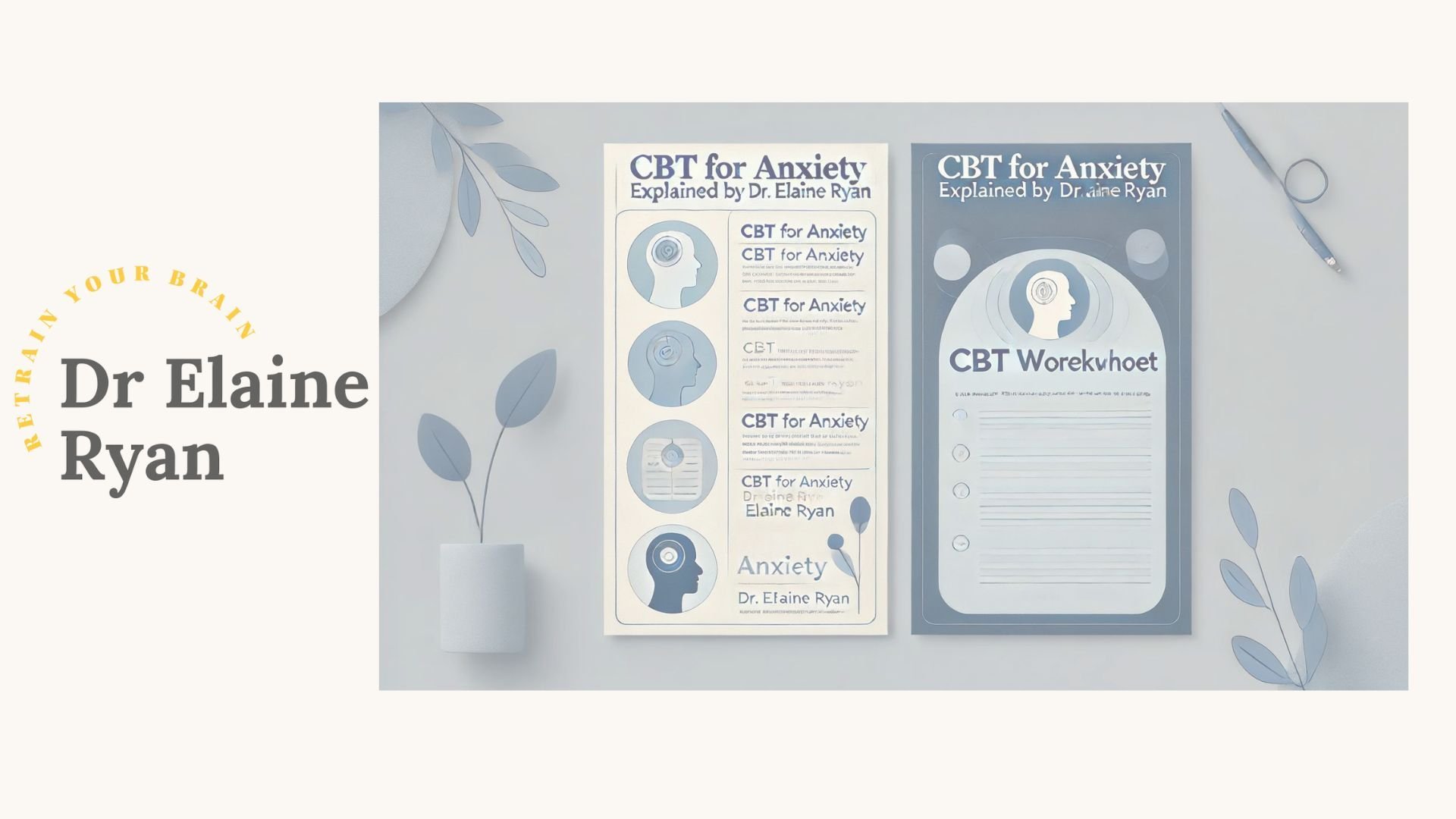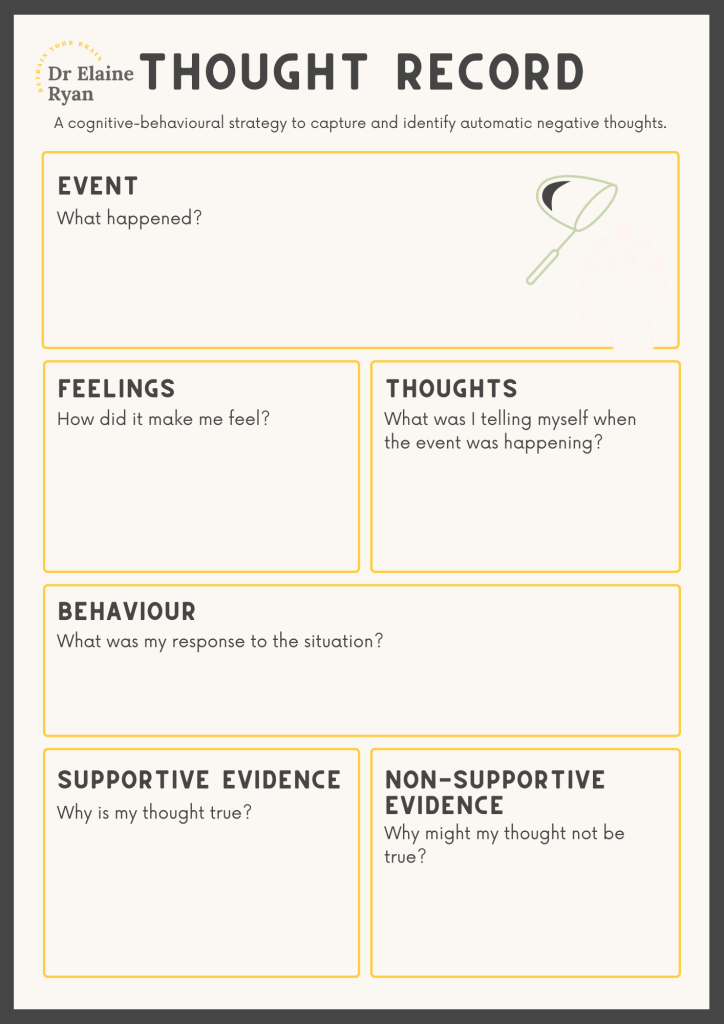Introduction
In Ireland, anxiety disorders are prevalent among the population. According to recent surveys, approximately 7% of Irish adults meet the diagnostic criteria for Generalized Anxiety Disorder (GAD) (Maynooth University) (Irish Practice Nurses). Additionally, broader measures indicate that anxiety affects around 74% of adults to varying degrees, with 48% experiencing anxiety frequently (Aware)?. Cognitive Behavioural Therapy (CBT) is one of the most effective treatments for anxiety, offering practical strategies to manage and reduce symptoms and today I want to explain a bit more about how it works.
Retrain Your Brain®

Dr Ryan’s online self-help course for anxiety
What is Cognitive Behavioural Therapy (CBT)?
Cognitive Behavioural Therapy is a talking therapy that helps you to understand the relationship between your thoughts, feelings, and behaviours. Developed in the 1960s by Aaron T. Beck, CBT is grounded in the belief that changing maladaptive thinking leads to changes in behaviour and emotional state. I shall explain that quickly before moving on.
Imagine Saoirse who has social anxiety and thinks, “If I speak in meetings, I’ll say something stupid, and everyone will think I’m a fool” This negative thought causes Saoirse to feel extremely anxious and avoid speaking up in meetings.
- Identifying Maladaptive Thought: Saoirse’s therapist helps her identify this automatic negative thought that triggers anxiety.
- Challenging the Thought: They work together to challenge the validity of this thought by asking questions like, “What evidence do you have that you will say something stupid?” and “Have there been times when you spoke in a meeting and things went well?”
- Reframing the Thought: Saoirse learns to reframe her thought to something more balanced, like, “I might feel nervous, but I can prepare and contribute meaningfully to the meeting.”
- Behavioural Change: With this new way of thinking, Saoirse gradually starts to participate in meetings. As she does this, she realizes that her fear of negative judgment was exaggerated, which reduces her anxiety over time.
By changing his maladaptive thinking, Saoirse changes her behaviour (participating in meetings) and her emotional state (reduced anxiety).

How CBT Works for Anxiety
CBT works for anxiety by addressing the distorted thinking patterns that contribute to your anxious feelings and behaviours. It focuses on identifying, challenging, and altering these negative thought patterns and replacing them with more realistic and balanced ones. Here’s how CBT helps in managing anxiety:
- Identifying Negative Thoughts:
- Example: Imagine you have a big presentation at work. Your automatic thought might be, “I’m going to mess this up, and everyone will think I’m incompetent.” In CBT, you learn to recognize this thought as a common trigger for anxiety.
- Challenging Negative Thoughts:
- Example: Your therapist might ask you to examine the evidence for and against your belief that you’ll mess up the presentation. You might realize that you’ve successfully delivered presentations before and received positive feedback, which challenges the initial negative thought.
- Changing Behaviour:
- Example: Instead of avoiding presentations out of fear, CBT encourages you to confront the situation. You might start with smaller tasks, like speaking up in meetings, gradually building confidence. Over time, this helps reduce anxiety around public speaking.
You can see in the image below a sample CBT thought record that you would typically use to record and change your thoughts and I have included the worksheet in PDF format for you to download.


Key Techniques Used in CBT for Anxiety
Several techniques are employed in CBT to help you manage anxiety:
Cognitive Restructuring:
- Example: Aisling often thinks, “If I don’t get everything perfect, I’ll fail.” In CBT, she learns to challenge this thought by considering more balanced perspectives, such as, “It’s okay to make mistakes; I can learn from them.”
Exposure Therapy:
- Example: Conor has a fear of flying. In session we gradually confront this fear by first looking at pictures of airplanes, then visiting an airport, and eventually taking a short flight. Each step helps reduce his anxiety.
Relaxation Techniques:
- Example: During stressful situations, Killian practices deep breathing exercises he learned in CBT. By focusing on his breath, he calms his mind and body, reducing his anxiety levels.
Behavioural Activation:
- Example: Aoife feels anxious about going out and often isolates herself. In session I encourage her to engage in activities she enjoys, like joining a book club. By doing so, she feels more accomplished and less anxious.
Benefits of CBT for Anxiety
CBT offers numerous benefits for those suffering from anxiety:
- Long-term Effectiveness: CBT provides you with tools and strategies they can use beyond the therapy sessions, promoting long-term management of anxiety. I always say in session that they whole idea of CBT is to make me redundant; you should get to a stage where you do not need your therapist and have the tools at your disposal.
- Skill-building: You learn practical skills to identify and challenge negative thoughts and manage their anxiety independently.
- Empowerment: By understanding the cognitive-behavioural model, clients feel more in control of their anxiety.
- Evidence-based: Numerous studies, including those by the American Psychological Association and the National Institute of Mental Health, support the effectiveness of CBT in treating anxiety.
If you are ready for therapy it is crucial that you not only find someone competent and trained in CBT but also a therapist that has extensive knowledge of anxiety and how to work within the model of CBT and apply it to anxiety.
Finding a qualified CBT therapist is crucial for effective treatment. Here are some tips to help you in your search:
- Check Credentials: Ensure the therapist is licensed and has specific training in CBT.
- Ask for Recommendations: Seek referrals from healthcare providers or trusted individuals.
- Research Experience: Look for therapists with experience in treating anxiety disorders.
- Initial Consultation: Schedule a consultation to discuss your concerns and gauge if the therapist’s approach aligns with your needs.
Additional Resources for Help
For further information and support, consider the following resources:
- BABCP: Provides a directory of CBT therapists
- National Institute of Mental Health (NIMH): Offers information on anxiety disorders and CBT.
- Read more on anxiety counselling here.

